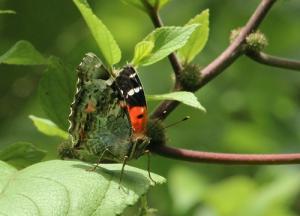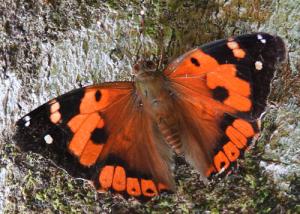
Female Kamehameha butterfly on mamaki; photo by Nathan Yuen
By Staff Reports
(Oahu)– The population of the Kamehameha butterfly—Hawai‘i’s state insect, which can be found nowhere else in the world—is on the decline, and University of Hawai‘i at Mānoa researchers are asking the public’s help to find out why. A team from UH Mānoa’s College of Tropical Agriculture and Human Resources (CTAHR) is launching the Pulelehua Project, which, with the public’s assistance, will map current populations of the butterfly. The Hawai‘i Department of Land and Natural Resources (DLNR) Division of Forestry and Wildlife is funding the effort.
“There are just a few of us who are trying to cover the entire state, and that’s impossible, so we really need the public to get an accurate assessment of the Kamehameha butterfly,” said Dr. Daniel Rubinoff, a principal investigator on the project and CTAHR professor of entomology.
Anyone who sees a Kamehameha butterfly, caterpillar, egg, or chrysalis is asked to submit their photos and observations to the Pulelehua Project website http://www.KamehamehaButterfly.com. The data will be used to map the current distribution of the Kamehameha butterfly (Vanessa tameamea, or pulelehua), which will help determine exactly what is happening to the species and why, and will help develop a strategy to preserve and possibly grow the population.

Male Kamehameha butterfly; photo by Nathan Yuen
“We need help from hikers and the conservation community, anybody that’s out there, in these areas where the butterflies are found,” said CTAHR researcher Dr. William Haines, who is also a principal investigator on the project.
The Pulelehua Project website shows how to find and identify the different life stages of the Kamehameha butterfly, with pictures of the eggs, caterpillars, chrysalises, and mature adults. “They’re basically a kind of deep orange, sometimes almost a rosy, pinkish hue, and they have white spots,” said Haines. “They’re really quite beautiful.”
The website also includes pictures of common lookalikes and the host plants where adults lay their eggs and the caterpillars live and eat. Kamehameha butterfly caterpillars are found only on the Hawaiian species of the nettle family (Urticaceae), located in shady areas or gulches with native vegetation and moderate to heavy rainfall. The most common host plant is māmaki (Pipturus albidus), though the larvae will also feed on olonā (Touchardia latifolia) and ōpuhe (Urera glabra).
The Pulelehua Project is an example of collaboration between researchers and the public known as “citizen science.” It is a technique that has been used increasingly in the past few years for large-scale collection of information.
The Pulelehua Project website features a map of all of the sightings, which are automatically updated as new observations are submitted and confirmed. Like all native wildlife in Hawai‘i, the Kamehameha butterfly is protected by law and collecting the species is not allowed without a state permit. For that reason, the website will show sightings by region but not specific locations.
The Kamehameha butterfly was officially adopted as the state insect in 2009, in response to a proposal by a group of elementary school students. Although the butterfly historically has been found on all of the main Hawaiian Islands except for Kaho‘olawe, it is no longer found in some areas where it used to be common, such as Tantalus on O‘ahu.
ABOUT THE PRINCIPAL INVESTIGATORS:
Will Haines studies the ecology, evolution, and conservation of island insects. In addition to managing the Pulelehua Project, he studies outbreaks of the koa looper moth (Scotoryrthra paludicola). He is currently a researcher in the Department of Plant and Environmental Protection Sciences (PEPS) in CTAHR.
Daniel Rubinoff, a professor in PEPS, is a director of the UH Insect Museum. He is working on projects that focus on using systematics to improve agriculture and conservation efforts in Hawai‘i and elsewhere.
Other project collaborators are Cynthia King, a CTAHR alumna and coordinator of the Native Invertebrate Program of the DLNR, and John Leeper, a retired entomologist and CTAHR alumnus who has been interested in the Kamehameha butterfly since he studied it as a graduate student.

